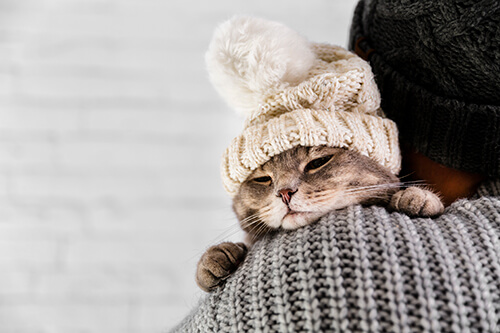
1. Ensure your pet’s shelter is warm and cozy
When the temperatures drop, it’s important to keep your pets inside the house with you. If you would be too cold spending all day outside, it’s too cold for your pets as well. This is especially true if your pet is not yet fully grown, or is sick.
If your dog house has been specifically outfitted for winter, it may be sufficient for keeping your pet warm. This means it should be big enough to be comfortable, but small enough to retain heat. The floor should be raised and covered with cedar shavings or straw, and the door should be covered with waterproof burlap or heavy plastic.
But again, we highly recommend keeping your pets indoors. If it’s more comfortable for you inside, it’s more comfortable for your pet inside too.
2. Bundle up!
Small pets and short-haired pets will appreciate an extra layer this winter, even for short walks. If they do not like walking in the snow, try booties! Fur can only go so far in keeping your pet warm.
Additionally, be sure to keep them dry, which will help with their heat retention. There are lightweight jackets perfect for your fluffy dog to keep him dry while he plays in the snow.
3. Keep an eye out for common winter hazards
Antifreeze is extremely toxic to cats and dogs. Unfortunately, it has a very sweet taste they’re highly attracted to. Keep antifreeze stored in a safe place, away from children and pets. Clean any spills immediately!
Likewise, rock salt is great at keeping us from slipping on ice, but it’s very bad for dogs. Be sure to wipe down your pet’s paws after each walk to avoid them licking it off themselves later. Use pet-friendly ice melts whenever possible.
4. Protect your pet’s feet
Booties can minimize contact with painful salt crystals, poisonous antifreeze, and chemical ice-melting agents. Booties can also help prevent sand and salt from getting lodged between bare toes, which may cause irritation.
Alternatively, massaging petroleum jelly into your pet’s paw pads before going outside can help to protect against salt and chemical agents. Bring a towel on long walks to clean off stinging, irritated paws.
After each walk, wash and dry your pet’s feet to remove any ice, salt or chemicals. Check for cracks in the paw pads, redness between the toes, or other signs of irritation. Moisturizing after a good toweling off can help to heal chapped paws.
5. Stay vigilant about fleas and ticks
As the temperatures drop, many pet owners believe that using flea control is no longer necessary, as the fleas will die off in the cold weather. But this is a common misconception!
A warm heated home provides the ideal environment for fleas to breed, which means flea control is a year-round commitment. Pets should be treated each and every month – even in the heart of winter – to ensure they remain protected from fleas and ticks 365 days a year.
By following these helpful tips, you can ensure your pet stays cozy, healthy and happy all winter long. In the meantime, contact us if you have ANY questions at all about keeping your pet safe this winter.